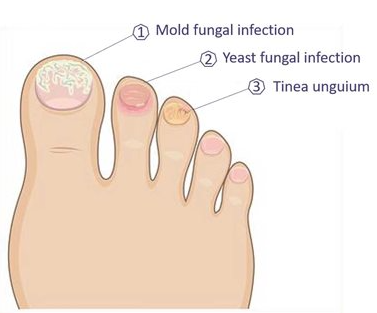THE FUNGUS AMONG US
A common foot condition which highlights the need for professional foot care is foot fungus. While foot fungus is common and treatable, it’s often hidden behind other common issues, like extremely dry or peeling skin. As a result, many people needlessly suffer through the itchiness and discomfort of foot fungus, masking symptoms with lotions and creams without getting to the root of the problem.
Do you recognize a foot fungus when you see one? It’s not always obvious. Read on to learn what foot fungus is, how to recognize it on a client, and the Footlogix® products developed specifically to treat it.
What is a Foot Fungus?
There are three types of fungus: mold, yeast, and tinea unguium and each is commonly found on the skin. However, healthy skin forms a barrier that protects the body from infection. Issues arise when skin is unhealthy or damaged. Then fungus can enter the body where the warm, moist environment allows the fungus to naturally overpopulate.
‘Tinea’ is a common term for dermatophytes, which are fungus that require keratin for growth. And because the skin, hair and nails contain keratin, dermatophytes are typically responsible for superficial fungal infections in these areas. For instance, tinea pedis (a term nail technicians should recognize!) refers to a dermatophyte infection of the foot―or simply foot fungus.
Bacterial infections are different from fungal infections. These types of infections are caused by bacteria and can often be identified by dark green discoloration under the toenail. (This is why many techs call them “the greenies.”) Bacterial infections can become serious very quickly. In these cases, a nail technician should always refer the client to a medical professional immediately.
Assessing the Skin of the Feet and Toes
Foot fungus generally presents as flaky and scaly skin that will often peel, crack, itch, and burn. The skin may also be rough and scratchy and is often mistaken for extremely dry skin. In severe cases, the feet may develop a foul odor, blisters, and sores. If the toenails are infected, they are often yellow, thickened, and brittle and may be lifting from the nail bed.
To properly assess a client’s feet, it’s not only important to be knowledgeable about all potential foot conditions and related symptoms, but also to be able to recognize healthy feet and nails. A healthy nail is always completely attached to the nail bed, slightly pink, translucent, and free of any spots or discoloration.
If a nail is unhealthy, you must consider the totality of symptoms in your assessment. For instance, just because a nail is separated from the nail bed (onycholysis), does not mean it’s a fungal issue. You must also make other observations, such as: Is the nail is thickened and/or does it have brown or yellow discoloration?
- Is the toenail brittle?
- Do the nails have a whitish, textured appearance? In some cases, the nails are just extremely dehydrated (keratin granulation), however this can also indicate a superficial fungal infection on top of the nail. Is the nail also spongy? This can indicate a fungal infection.
- Is there debris under the nail? And, if so, does the client suffer from nail psoriasis which impacts the nail’s cellular turnover and causes what appears to be debris, but is not fungal.
- Have toenails or skin around the nail been disrupted (damaged) in any way which may have allowed a fungus to enter and grow?
Footlogix® Foot Fungus Treatment
If a client suffers from a foot fungus, Footlogix® has a full range of anti-fungal or anti-microbial solutions which can deliver transformational results. Foot care professionals can be confident recommending these home-care solutions to literally anyone because they are safe for use by everyone, including diabetics, seniors, and immune-compromised clients.
Footlogix® has developed both anti-fungal or anti-microbial treatments to treat fungal infections. Depending on the country you live in – you may be working with our Anti-Fungal Line or our Anti-Microbial Line of products.
Explore the Footlogix® Anti-Fungal product line and start clients on the road to healing today!
Footlogix® Peeling Skin Formula: This product contains Clotrimazole and no added moisturizers. It was developed specifically for the care of clammy skin prone to fungal infections.
Footlogix® Rough Skin Formula: This product was developed to treat dry, rough skin with superficial cracking. In addition to Clotrimazole, the Rough Skin Formula contains urea to lock in moisture and eliminate dry, rough heels and feet.
Footlogix® Anti-Fungal Toe Tincture Spray: This unique formula with Clotrimazole specifically treats fungus of the toenail. It contains Panthenol and Avocado oil to transform unsightly, discolored toenails to their optimum health.
Explore the Footlogix® Anti-Microbial product line and start clients on the road to healing today!
Footlogix® Peeling Skin Formula: With the proprietary ingredient Spiraleen®, an effective anti-microbial agent and it protects and cares for clammy feet prone to Athlete’s foot. Spiraleen® works by inhibiting the invasive germs with its highly efficacious anti-fungal, anti-viral and anti-bacterial properties resulting in a stronger skin barrier for healthier feet
Footlogix® Rough Skin Formula: Contains the proprietary anti-microbial ingredient Spiraleen® and it is effective in treating superficial cracks, dry, rough, scratchy or sand-paper like skin prone to fungal infections. Spiraleen® inhibits invasive germs with its highly efficacious anti-fungal, anti-viral and anti-bacterial properties resulting in a stronger skin barrier
Footlogix® Anti-Fungal Toe Tincture Spray: Effective in treating discolored toenails prone to fungal infections. Contains Spiraleen®, an effective anti-microbial ingredient and Panthenol and Avocado oil to transform unsightly, discolored toenails to their optimum health.
Source: Footlogix

